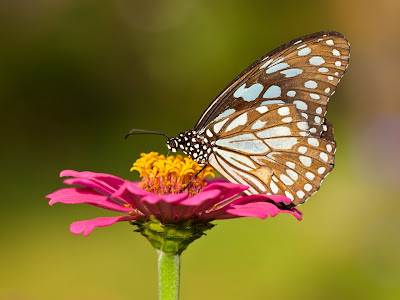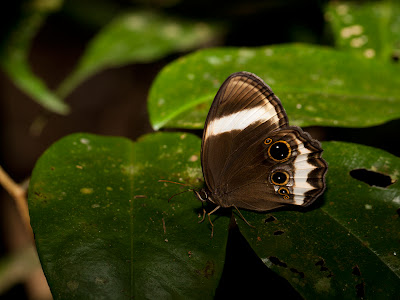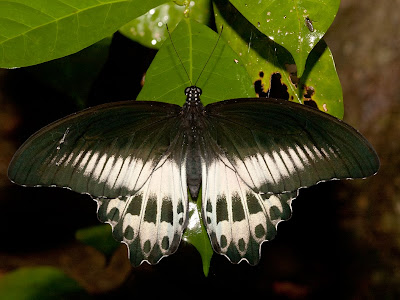Running after butterflies are considered children’s job; to capture stunning images a Photographer has to do just that and more. Capturing of class images requires a lot of knowledge of the behavior of the subject. In fact subject knowledge sits right on top of the photographer’s foundation of knowledge. Here butterflies being our subject; understanding how they will behave comes top.
In our previous article we dealt with the best places to find butterflies; now it is time for us to learn what time is best to photograph them; along with it some entomology (insect science) of these creatures.
Best Time of the Year to Photograph Butterflies
Butterflies depend on the warmth of the sun to warm their bodies and get their metabolism gather speed. As a result most butterflies get active when temperature has risen above 60º Fahrenheit (F) or 16º Celsius (C).
In India the two seasons as peaks for butterfly abundance are March-April and October. In countries with colder climates one can see butterflies emerging in April and their numbers continues to rise as the weather gets hotter.
Peak season is usually from July to September. Butterfly activity starts to decline at the onset of autumn and almost ceases by later November as the approaching winter causes temperatures to fall below 50ºF/10ºC. Butterfly activity will resume when the temperatures rise in the spring.
Best Time of the Day to Photograph Butterflies
Depending on where you live and how early the sun rises some butterflies could be seen as early as 7am but most become active by 9 or 10am. They will remain active till evening 5 – 6pm. After which only some species remain active. In warmer climates, the optimal temperature for butterfly activity is reaches earlier in the morning than in northern climates. It’s a good idea to keep a diary and note down the time when each species of butterfly first appear and when they leave for the night.
Ideal Weather Conditions for Butterfly Photography
Sunny days with little or no cloud cover and wind are the ideal conditions for photographing butterflies. Photographing them when they are very active may be a bit difficult. A dip in temperature caused by a passing cloud may make them to stay relatively still conserving energy.
Similarly during midday when temperatures soar above 95º F (32ºC) there is a decline in butterfly activity as they rest in some shade. Butterflies don’t like windy or rainy days and are less active and usually hide under leaves or crevasses.
Understanding Basic Butterfly Behavior and Photographic Opportunities
Basking
Butterflies frequently bask in the sun to get their metabolism running; during basking they will try to align their wings to the sun’s rays to capture most heat. Some butterflies are ‘lateral baskers’ and will keep their wings close at right angles to the sun and others are ‘dorsal baskers’ and will open their wings and align them with the sun’s position for maximum exposure.
They will not fly off until they are warm enough or disturbed. Basking is a good time to photograph butterflies and if carefully approached there are chances of getting great pictures with wings fully open showing all the magnificent patterns and textures in their wings.
Feeding
Feeding is one of the best times to photograph butterflies; adult butterflies require to feed on high energy nectar; some also feed on various salts, minerals, alkaloids, pollen etc. the urge to feed makes butterflies tolerate a close approach thereby giving you good opportunities.
Observe butterflies closely, identify the plants they prefer for feeding, note how long do they spend on each flower, are they returning back to the same flower etc. these information about feeding patterns will help you understand them and plan your strategy to get great pictures.
Drinking / Puddling
Some species of butterflies frequently gather in groups (both small and large) around moist soil usually found around streams, rivers or lakes. This is called puddling (mud puddling). They could either be drinking water or absorbing minerals from the soil. This is also a good time to photograph butterflies; they are usually immersed in their activity and are not easily disturbed.
Resting
Butterflies do rest when the temperature becomes too hot or after a hearty meal. Usually they prefer shady areas like under a bush or a leaf where they won’t be easily spotted by potential predators. They will sit still for a while until ready to go back to seek mates, eat, or drink and if approached cautiously you could photograph them easily, major problem will be lack of light or poor quality of light (dappled light).
Perching
Some butterflies perch in some prominent positions on shrubs in an open area, they rest on the tip of the top most branch and scan the surroundings for receptive females or trespassing males. Even though they fly off when they find any they’ll usually return to their favorite perch. Perching butterflies can be photographed, just make your approach slow giving the butterfly time to get used to your presence.
Roosting
Butterflies spend the night in crevasses or in the bark of trees or under overhangs or logs. Roosting locations are carefully selected sites which will offer protection from the elements and also keep the butterfly well hidden from predators. Some butterflies return back to the same roosting spot night after night.
If you go out at night you’ll find butterflies sleeping in such locations. Roosting butterflies could be easily photographed but such images won’t make great photographs.
Shelter
When there is heavy rain or strong winds, or when the weather gets too chilly, butterflies take refuge under leaves, branches or similar spaces. When one is found in such a state; you could easily get pictures as they won’t easily fly off.
Patrolling
Male butterflies patrol their territory looking for receptive females or challenging males that needs to be chased away. Butterflies patrolling are moving too fast, too erratically, and too high to bother photographing. It’s better to wait for them to return to their favorite perch.
Courtship
The courtship ritual of butterflies is interesting; males perform a little series of dances next to the female or hover around her to see if she is receptive. Sometimes the efforts pay off and result in successful mating but often the female simply flies off in search of food or a better partner. The courtship ritual only lasts a few seconds and combined with the erratic movements make it very difficult to photograph.
Mating
Mating occurs if the courtship is successful; once they begin to mate it takes a while to complete the process. Mating butterflies are locked together and are usually intent on their activity. So this is an ideal time to photograph them, however if disturbed they can fly away still joined.
Looking for Host Plants
Butterflies are equipped with chemo-receptors on the bottom of their feet and antennae. These receptors allow them to detect odors from plants and thus choose the right host plant to deposit their eggs. Photographing butterflies looking for host plants is very difficult as they often fly in zigzag pattern all over the place looking for the right plant and making sure there are no eggs on it already to prevent competition of food.
Depositing Eggs
If you find a butterfly looking for host plants, just follow it. It will soon find a suitable plant and start laying eggs, they do it by bending the tip of their abdomen down to the surface of the leaf. Some butterflies lay their egg on the top of the leaf while some lay it on the underside. When you find a butterfly hopping from plant to plant inspecting them you know what they are looking for, butterflies which lay single eggs don’t stay long on a plant, but those that lay many eggs spend enough time for you to take some nice pictures.
Migration
With the change of seasons, some butterflies migrate from one area to another in search of better living conditions or to survive harsh winter. In tropical areas migration usually occurs from the hills to the valleys and back. Some butterflies migrate across continents.
The migration of Monarchs from the northern parts of the United States and Canada down to their wintering grounds in Southern California (western Monarchs) and Mexico (eastern Monarchs) is famous world over. These Monarchs end their migration at their winter roosting areas, where millions of Monarchs gather in trees and warmer weather allows many (with high mortality rates) to survive the winter and begin the migration north the following year.
Migrating butterflies often stop in various places en-route where they feed and rest thus providing ample of opportunity to photograph them.
Final Days
Butterflies have a life span ranging from a week or two to about a month or two. Those that survive and live the length of their life span can be easily identified. They lose much of their color, look battered and torn from bird attacks. Old butterflies are not as skittish as young ones, but may not be as attractive to photograph.
Related Reading
- Hyper Focal Distance in Digital Photography - What is it? - How to Calculate? and How to Use it to Maximize Depth of Field
- The Golden Rule of Landscape Photography
- 20 Common Mistakes Beginners Make in Landscape Photography and How to Avoid Them
- 22 Tips for Photographing Stunning Seascapes
- Professional secrets of Night Photography for Capturing Stunning Star Trails and Moonlit Landscapes













Post a Comment